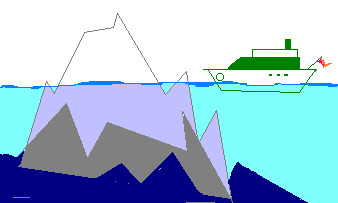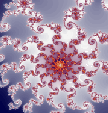
|
|
 |
DOLLS and EXOTIC NATIVESThe stock metaphor for culture in popular culture is pictures (usually of women) or of dolls dressed in festive native costume. Think of Disney's "It's a small world after all" or the decades of National Geographic covers. When we speak of "the Germans" or "the Russians" we call up these visual metaphors which equate culture with national identity, and imply that culture is relatively uniform and unchanging. These photos and dolls simplify and essentialize the "Other". They are usually cute, young, timeless, unthreatening. (Notice that the National Geographic cover shown here plays with its old reputation by placing a mother/daughter photo on the cover that startles the viewer with changes and contradictions in culture and identity.) |
|
FORCE FIELDSSchein uses this metaphor from his mentor Lewin from the heady days of Physics in mid-century. Social energy is generated by "movement through context." Forcefields are not directly visible but are unifying and powerful. The metaphor implies that culture is beyond individual control or individual characteristics, a system that is dynamic, with actions and reactions, yet mysteriously orderly. |  A related metaphor from Schein and Lewin is "unfreezing", which happens when cultural difference challenges the ego (the magnetic forces shift). Eventually the organization or personality realigns and "refreezes" into new patterns. A related metaphor from Schein and Lewin is "unfreezing", which happens when cultural difference challenges the ego (the magnetic forces shift). Eventually the organization or personality realigns and "refreezes" into new patterns. |
|

|
CULTURE SHOCKOberg popularizes this medical/psychological metaphor for the difficulties of adapting to an unfamiliar culture (innoculation achieved through intercultural training...). |
|
The ICEBERGThe popular iceberg metaphor illustrates "hidden culture": the world of assumptions, habits, beliefs that may not be consciously articulated or taught. The metaphor implies danger, the necessity of having a skilled pilot, and justifies the use of cultural experts as there is much more to culture than meets the eye. |
 | |
 |
AROUND THE CAMPFIRE: Recounting tribal heroic mythsDeal & Kennedy's landmark Corporate Culture brings classic anthropology terms such as ritual, clan, and tribe into business. (Joseph Campbell and Robert Bly are bringing mythology and drumming to a larger audience during the same period.) The metaphor implies that culture is "primitive", powerful, timeless, and that a strong head man can reshape it. | |
COMPASS or X mark: YOU ARE HERE!F. Kluckhohn, Hofstede, Trompenaars, and many followers: measuring value orientation of cultures along a continuum. The metaphor is geographic--it locates cultures on a two-dimensional line--and scientific, in that it measures data and produces a numeric, presumably reproducable, location for each given culture. The metaphor is useful because it is easy to grasp, does not value one orientation over another, outlines key differences in culture that affect business, and eases anxieties by giving people the satisfaction of knowing how they measure up, where cultures are situated. |  |
|
 |
JELLY BEANSRoosevelt Thomas: All jelly beans in the organizational jar are "diverse" not just the red ones or purples ones. Thomas also gives us Organizational Culture as a giant tree, and Culture as a house--an elephant can invite friend giraffe to live together, but the giraffe will not be able to stay long in the elephant's low ceilinged house. |
|
MELTING POTS & SALAD BOWLSPopular metaphors for the relationship of immigrant cultures within a larger nation or dominant culture have shifted from the melting pot to the salad bowl. In the latter, immigrant cultures maintain their original integrity in the new national salad. More cynical observers may note that whether it is stew or salad, it all gets eaten and assimilated in the end. |   |
|
 |

MIND MAPSTwo maps here--the geographic one represents the internal maps people have of their cultural terrain, knowing that "the map is NOT the territory" that reality is always vastly more complex than our mental renderings of it. The other is a mind-map, which depicts the network of associative links in our minds--knowledge triggered by a single word, for example, or the feelings and meanings we associate with a particular behavior. These associations are partly personal, partly collective. Culture in this metaphor is the map of a group's shared meanings and connections. |
|
CELEBRATION!of diversity, multiculturalism. Notice the metaphor and what it unintentionally communicates: we celebrate holidays, occasions, "special" events. This subtly implies that multiculturalism is decorative, fun, but special, not for ordinary "real" days or for "real" work. |  | |

|
ORGANISMThis biological metaphor sees culture as living, organic, in motion. There are boundaries between internal and external; the organism (and culture) survive by controlling that boundary--allowing nutrients and waste to pass the boundaries, but keeping out foreign intrusions. Within a culture there will be different functions and roles, yet there is a common being-ness. | |
CHAOS!Senge, organizational systems theory. Culture is too complex to "manage", should be looked at with awe. One can strive to understand main loops of cause and effect, but realize that you are only capturing a simple version of the mathematically chaotic whole, and that one cannot predict all the effects your actions will create throughout the system. |  | |

| SOFTWARE OF THE MINDHofstede's book of that title uses the primary metaphor of the decade as the boundary between what is human and what is machine is increasingly hard to maintain: the brain as the computer's CPU (=nature, hardwiring) and the mind's culture/knowledge as software. Software is based on algorithms--recipes of sorts--designed by humans for human purposes, then edited and elaborated by future users and programmers. |
|